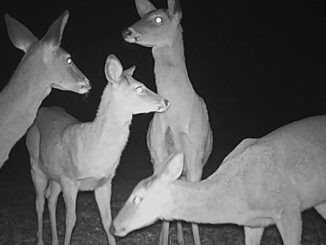
Second Tensas deer did have Chronic Wasting Disease
A second deer harvested in Tensas Parish has been confirmed to have Chronic Wasting Disease (CWD).
Dr. James M. LaCour made the announcement at the Louisiana Wildlife and Fisheries Commission’s monthly Dec. 5 meeting. LaCour is the Louisiana Department of Wildlife and Fisheries (LDWF) state veterinarian.
The second deer was harvested approximately five miles from the first CWD-affected deer, which was found last year. The 5 1/2 year-old buck was approximately 60 pounds lighter than the average weight for a deer his age.
“I don’t know if the deer crossed paths or saw each other or ultimately ate at the same feeder,” LaCour said. There are numerous ways the two deer could have come in contact and spread the disease.
LDWF officials have collected DNA from the second CWD-affected deer to find out if it was a “local deer.” According to LaCour, DNA was also collected from the first CWD-affected deer.
“That deer, through DNA testing, was found to be a local deer to that region. But it may very well have came from Mississippi,” he said. “If you back track, it may originally came from Tennessee.”
The current deer was harvested Dec. 3 and turned into LDWF officials. Samples were returned from the National Veterinary Services Laboratory in Ames, Iowa.
The state wildlife veterinarian said the Tensas hunters used the appropriate measures for disposing of the carcass.
“We’re fortunate that the hunters use a dumpster for carcass disposal, and they did dispose of that deer’s carcass in the dumpster. It went to a landfill,” LaCour said. “That’s the best case scenario for the disposal of the carcass.”
Samples tested
Meanwhile, LaCour said 1,733 harvest deer samples have been obtained in Louisiana. In the CWD Control Area, 50 samples have been taken from Franklin Parish, 121 samples from Madison Parish and 217 samples from Tensas Parish. An estimated five percent of the harvested deer in Tensas Parish have been tested. This is the only sample to test positive so far this season. Results are typically running two to three weeks from the time samples are turned in to receiving the test results, which are posted on the LDWF website.
“If the tests are positive, we will contact the hunter as soon as we get a suspect from the laboratory and contact them again when we get the results from the national lab,” LaCour said.
He estimated an additional 100 samples will be taken due to the second case of CWD. LDWF’s goal of 300 samples set last year has been met.
“December 28, we heard from the lab and got our guys rolling,” LaCour said. “As of yesterday, (Jan. 4) we had over 60 new samples from that area. They are getting with it and doing a great job.”
To help with sample collecting, LDWF instituted cooler locations where hunters can drop off their deer heads without taking them out of the control area. LDWF has received 127 samples from the cooler program which LaCour called “significant.”
LDWF has also received 137 samples from taxidermists.
“That is the value of the taxidermy test,” he said. “Taxidermist get mature bucks in their offices and shops.”
Mature bucks
Mature bucks are the prevalent deer for CWD testing. The disease takes 16 – 24 months to develop clinical signs once the deer ingests the prions. The deer starts shedding the prions after the 16 – 24 months. Prions are misfolded proteins that have the ability to transmit their misfolded shape onto normal variants of the same protein. They characterize several fatal and transmissible neurodegenerative diseases in humans and many other animals.
“Bucks, due to their behavior, lick branches, rub and maybe even fight tend to pick up the prions more often than does,” he said. “But does can be affected.”
When asked could CWD be eradicated, LaCour responded, “It will probably not be possible to eradicate the disease. That hasn’t been done in the other states. Our goal is to reduce the spread of the disease.”
There is no evidence CWD, which makes deer resemble “the walking dead,” can spread to humans.

